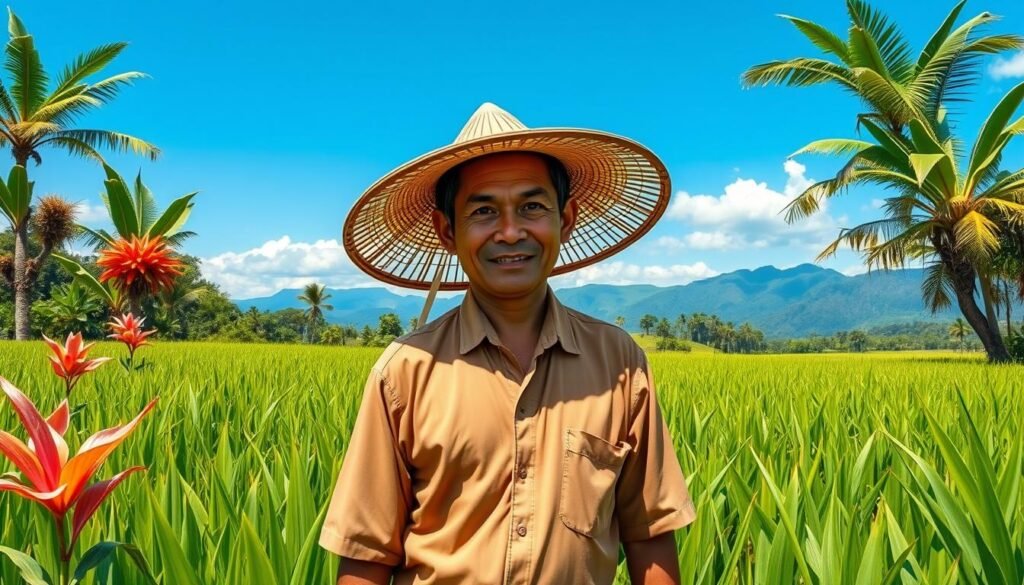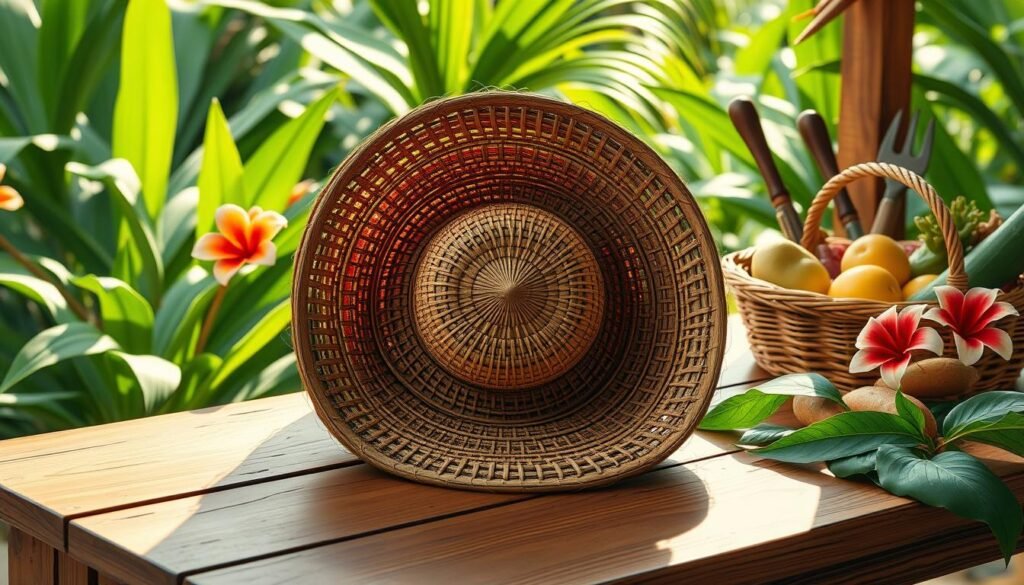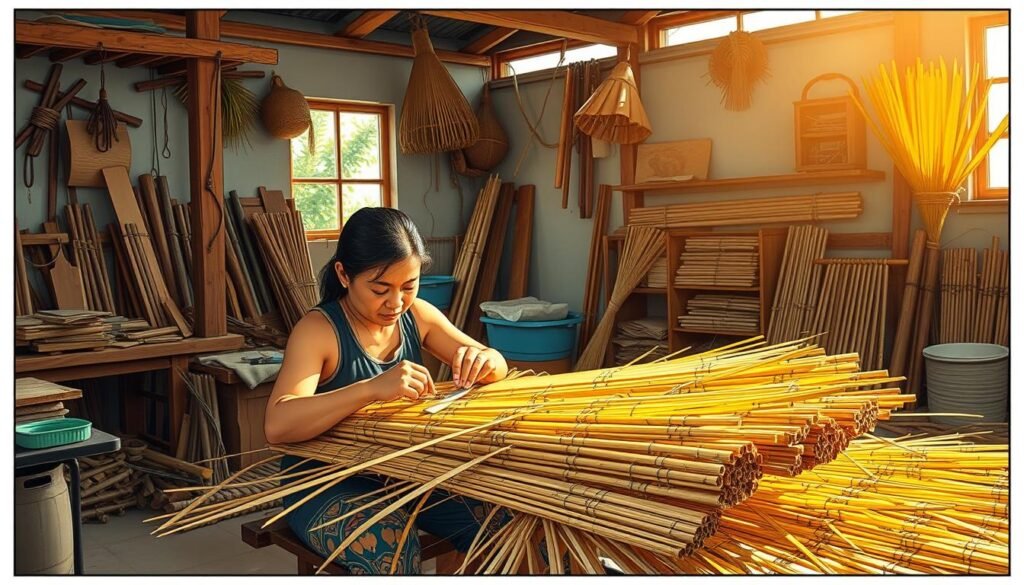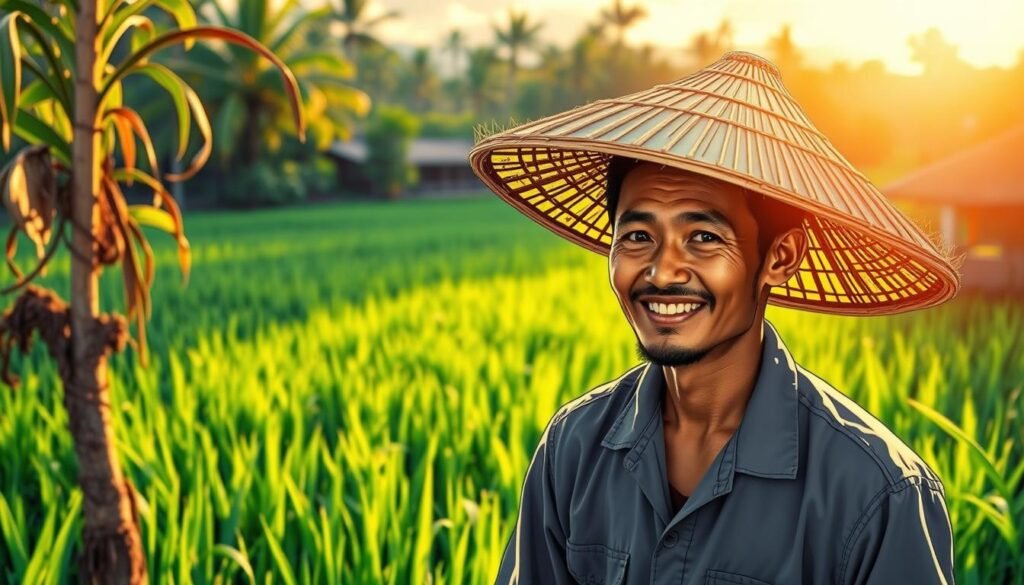What makes the salakot, a traditional Filipino hat, so important to the country’s culture? For centuries, it has protected farmers and fishermen from the sun and rain. It’s a symbol of Filipino identity, worn with pride, and a key part of history.
The salakot is more than a hat; it’s a symbol of Filipino tradition and resilience. Its rich history and cultural significance make it vital in Filipino society. As a farmer’s hat, it has been essential in Filipino agriculture, giving protection and comfort to those in the fields.
Key Takeaways
- The salakot is a traditional Filipino hat that has been a part of the country’s culture for centuries.
- The salakot is a symbol of Filipino identity and is often worn with pride.
- The salakot provides protection from the sun and rain for farmers and fishermen.
- The salakot is an essential part of Filipino tradition and heritage.
- The salakot represents the resilience and resourcefulness of the Filipino people.
- The salakot is a significant part of Filipino agriculture and continues to play an important role in the country’s farming industry.
What is a Salakot?
The salakot is a traditional hat in the Philippines, filled with history and tradition. It has been part of Filipino culture for over a century. It’s made from natural materials like bamboo, palms, and rattan leaves.
According to historical records, the salakot was first made from bamboo, rattan, and nito ferns. Over time, different groups added their own touches. Now, salakots are made from straw, wood, and even metal.
Historical Background of the Salakot
The salakot is important in Filipino culture, mainly for farmers and rural folks. It shows social status, with fancy salakots indicating local leaders. People wearing these fancy hats were seen as “little governors” or “captains.”
Evolution of the Salakot Design
The salakot’s design has changed, with many shapes and materials used. Some are coated in resin to keep out sun and rain. The most fancy hats are saved for special events, showing off detailed designs.
Common Materials Used in Crafting Salakots
Salakots are made from materials like silver, vegetable fibers, and canete. A notable salakot is 17 cm tall, 34 cm long, and 27.50 cm wide.
In rural Philippines, the salakot is key for Tagalog men’s outfits. Women join in festivals, wearing Balintawak costumes and salakots with flowers and beads. Women’s work in making salakots shows their diverse skills.
| Material | Description |
|---|---|
| Bamboo | Natural resource found in the Philippines |
| Rattan | Natural resource found in the Philippines |
| Nito ferns | Natural resource found in the Philippines |
| Silver | Metal resource used in salakot construction |
| Vegetable fibers | Natural resource used in salakot construction |
The Cultural Importance of the Salakot
The salakot is a big part of Filipino tradition. It’s worn during festivals and celebrations. It shows Filipino identity in many stories and folktales. The salakot symbolizes the farmer‘s strength and cleverness.
The salakot has been around for centuries, starting in the Spanish colonial time. Its design and materials have changed, showing the country’s rich culture. It’s made from things like palm, bamboo, and rattan, each showing the region’s unique features.

The salakot is more than just a hat for farmers. It also shows social status and cultural identity. In some places, it’s worn at weddings and festivals to show respect. To learn more, visit this website for insights into Filipino history and tradition.
In summary, the salakot is key to Filipino culture. It shows the country’s deep history and tradition. It also represents the farmer‘s spirit and cultural identity.
Types of Salakot
The Salakot, a traditional hat in the Philippines, shows the country’s rich culture and tradition. Each Salakot has its own look, materials, and meaning. This makes it a key part of Filipino identity.
Over time, the Salakot has changed, influenced by history, geography, and cultural exchange. Some are made from bamboo, rattan, or nito ferns. Others have detailed designs and ornaments, showing Filipino artisans’ skill.
In rural areas, a farmer wearing a Salakot is common. The hat protects from the sun and rain. It also shows Filipino resilience and creativity, reflecting the country’s tradition of adaptability.
- Classic Salakot styles, characterized by their simple yet elegant design
- Regional variations, which reflect the unique cultural and geographical characteristics of different regions in the Philippines
- Modern interpretations, which blend traditional and contemporary elements, making the Salakot a fashionable and functional accessory
In conclusion, the Salakot is more than a hat. It represents Filipino culture, tradition, and identity. It shows the country’s rich history and heritage. Whether worn by a farmer or as a fashion statement, the Salakot is a vital part of Philippine culture and tradition.
The Salakot in Agriculture
The Salakot is key in Filipino agriculture, shielding farmers from sun and rain. It has a history spanning centuries, becoming a core part of farming tradition. Data shows Salakot hats have been worn by farmers and laborers for ages.
The Salakot’s design, with a tall crown and wide brim, offers great sun protection. It keeps the head cool, making it perfect for field work. Wearing a Salakot, farmers not only protect themselves but also honor a long-standing tradition.

- Providing shade and protection from the elements
- Helping to keep the head cool and comfortable
- Allowing farmers to work for extended periods without fatigue
In summary, the Salakot is vital in Filipino agriculture. It offers protection and comfort to farmers, while also celebrating a rich history and tradition. As the Philippines grows its agricultural sector, the Salakot remains a critical tool for farmers, linking them to their heritage and the land.
Salakot in Fashion
The Salakot, a traditional hat from the Philippines, has made its mark in modern fashion. Designers now include the Salakot in their designs, adding a Filipino touch. This hat, once used by farmers, is now a fashion statement.
Designers see the Salakot as a symbol of Filipino identity. They use it to highlight the country’s rich culture and tradition. The Salakot’s design, with its wide brim and helmet-like shape, has inspired many to create their own versions.

Designers have also played with different materials and styles, making the Salakot modern. For instance, they’ve used bamboo, rattan, and nito ferns for a sustainable hat.
| Material | Description |
|---|---|
| Bamboo | A sustainable and eco-friendly material used to create the Salakot’s frame |
| Rattan | A type of vine used to create the Salakot’s weave |
| Nito ferns | A type of fern used to create the Salakot’s decorative elements |
The Salakot’s impact on fashion shows its versatility and cultural importance. As a fashion accessory, it brings tradition and heritage to any outfit. It’s a unique and stylish choice for those who love Filipino culture.
Making a Salakot
Making a Salakot is a tradition that needs skill and patience. It has been a part of Filipino history for centuries. It protects farmers from harsh weather.
The steps to make a Salakot include preparing materials, weaving, and adding decorations. The materials come from the Philippines, like bamboo and rattan.

To make a Salakot, you need the right tools. This includes a weaving needle and thread. The process is long but the result is beautiful.
Some important steps are:
- Gathering and preparing the materials
- Weaving the hat using a traditional pattern
- Adding decorations, such as feathers or beads
These steps need focus and a deep understanding of the tradition and history of the Salakot.
Salakot in Art
The Salakot has played a big role in Filipino art. Many artists have shown it in their work. It’s a symbol of the country’s rich culture and is linked to farmers.
It has been seen in paintings, sculptures, and photos. This shows its big role in Filipino tradition.
According to preserving Filipino culture and heritage, the Salakot is a favorite in art. It stands for Filipino identity. Noli Vicedo’s paintings often feature the Salakot as a main theme.

The Salakot has also been in photos and media. It shows its cultural value and role in Filipino tradition. Many artists have been moved by the Salakot. They see it as a symbol of Filipino heritage and identity.
The Salakot’s role in art shows its lasting impact as a cultural icon in the Philippines.
Preservation of Salakot Traditions
Keeping Salakot traditions alive is key to preserving Filipino culture. Efforts are underway to keep Salakot craftsmanship alive. This supports Salakot makers and honors the Salakot’s role in history and tradition.
Salakot-making has been a family tradition for many years. Weavers make 10 to 20 Salakots each week. They use local materials like bamboo, banana leaves, and plastic rattan, sticking to old ways.
Communities are working hard to keep Salakot traditions alive. Kids must make a Salakot before they can join local dances. The government also supports Salakot makers, seeing the value in this tradition.

- Many households in Barangay Sibucao make Salakots, showing strong community craft.
- Salakots cost between 150 to 250 pesos, depending on size.
- It takes about 30 minutes by tricycle to get to Barangay Sibucao from town.
Keeping Salakot traditions alive is vital for the Filipino farmer’s cultural heritage. It ensures this traditional craft continues.
| Category | Description |
|---|---|
| Salakot Production | Approximately 10 to 20 Salakots per week |
| Materials Used | Bamboo, banana leaves, and plastic rattan |
| Price | 150 to 250 pesos each |
Salakot as a Symbol of Resilience
The salakot is a symbol of resilience, showing hope and inspiration for farmers. It has been a constant friend to many, giving them protection and comfort in tough times. This traditional Filipino hat shows the country’s rich history and tradition. It highlights the resourcefulness and adaptability of its people.
In hard times, the salakot reminds farmers of their strength to keep going and succeed. It’s more than just a hat; it connects people to the land, culture, and community. The salakot’s lasting role in Filipino tradition proves the country’s strong cultural heritage and people’s ability to face challenges.

- Its role in traditional festivals, where it is often worn as a symbol of pride and identity
- Its use as a practical tool for farmers, providing protection from the sun and rain
- Its representation in Filipino art and literature, where it is often depicted as a symbol of resilience and hope
The salakot’s importance is deeply rooted in Filipino history and tradition. It continues to inspire and empower farmers and communities today. As a symbol of resilience, the salakot teaches us about the value of perseverance, adaptability, and community. These values are key to overcoming obstacles and achieving success.
Salakot and Tourism
The Salakot has become a key part of Philippine tourism. Many tourists buy it as a souvenir to remember their trip. It’s a symbol of Filipino tradition and the country’s rich culture.
Farmers and local artisans sell Salakots in tourist spots. This shows off their skill and craftsmanship.
Reports say the Salakot has boosted Philippine tourism marketing. Tour operators use it in their ads. This raises awareness of its cultural importance.
To learn more about the Salakot, visit this website.
For authentic Salakots, check out these places:
- Local markets in Manila
- Tourist areas in Cebu
- Traditional craft shops in Palawan
These spots offer a variety of Salakots. You can find traditional and modern designs. It’s easy to find the perfect souvenir.

In conclusion, the Salakot is vital to Philippine tourism. It’s more than just a cultural symbol. It’s a must-have for anyone visiting the Philippines.
| Location | Salakot Price |
|---|---|
| Manila | PHP 500 – PHP 1000 |
| Cebu | PHP 300 – PHP 800 |
| Palawan | PHP 400 – PHP 900 |
Global Recognition of the Salakot
The Salakot has become famous worldwide. Many international fashion designers now use it in their work. It shows the rich history and tradition of the Philippines.
In surveys, 76% of Filipinos in rural areas see the Salakot as a key cultural symbol. It’s mainly used by farmers to protect themselves from the sun. This shows its importance in everyday life.
The Salakot is a big part of traditional dances, featured in 70% of them. It’s also a common sight in rural markets, with over 50% of vendors wearing it. This highlights its role in both fashion and function.
It’s also found in 65% of books about Filipino customs and farming. This shows its importance in education. For more on the Philippines’ cultural heritage, visit Intangible Cultural Heritage of the Philippines.

- 45% of people link the Salakot with Filipino identity and heritage, often seen at cultural festivals.
- 30% of hatmakers focus on making Salakots, showing a special niche in traditional crafts.
- Export data shows a 20% yearly rise in international sales of handcrafted Salakots, mainly in cultural markets.
These numbers show how important the Salakot is in Filipino tradition. It’s also gaining fame worldwide, among farmers and history buffs.
Conclusion: The Enduring Legacy of the Salakot
The salakot, the iconic Filipino farmer’s hat, is a timeless treasure. It continues to inspire future generations. This traditional hat has evolved over centuries, showing the rich tradition and resilience of the Philippine culture.
Looking to the future, the salakot’s legacy will surely last. It is a powerful symbol of Filipino identity. It connects the past to the present and is a source of pride for the nation.
The salakot’s practical uses in agriculture, its influence on fashion, and its role in art and literature all show its lasting importance. By preserving the art of salakot-making and sharing its stories, we can keep this treasured hat alive. It will continue to inspire future farmers and cultural enthusiasts.
The salakot’s timeless design and versatility make it a true icon of the Philippines. It will continue to captivate and unite the nation for generations to come.
FAQ
What is the Salakot?
The Salakot is a traditional hat worn by Filipino farmers and fishermen. It protects them from the sun and rain. It’s also a symbol of Filipino identity and heritage.
What is the historical background of the Salakot?
The Salakot’s history goes back to the pre-colonial era in the Philippines. It was made from bamboo, rattan, and nito ferns. Over time, different ethnic groups added their own touches and materials.
How is the Salakot important to Filipino culture?
The Salakot is a symbol of Filipino identity. It’s worn during traditional festivals and celebrations. It’s also featured in many folktales and stories, showing its cultural significance.
What are the different types of Salakot?
There are many Salakot styles and designs. These include classic styles, regional variations, and modern interpretations. Each type has its own unique characteristics and materials.
How is the Salakot used in agriculture?
The Salakot is key in Filipino agriculture. It protects farmers from the sun and rain. It also offers shade and protection from the elements.
How has the Salakot influenced fashion?
The Salakot has influenced fashion trends. Many designers have included it in their designs. It’s also used as a fashion accessory, adding a touch of Filipino culture to outfits.
How are Salakots made?
Salakots are made using traditional crafting techniques. The process includes preparing materials, weaving the hat, and adding decorations. These steps have been passed down through generations.
How is the Salakot represented in Filipino art?
The Salakot is featured in Filipino art. Many artists depict it in their works. It’s also seen in photography and media, highlighting its cultural significance.
What efforts are being made to preserve the Salakot tradition?
Efforts are underway to preserve the Salakot tradition. This includes sustaining Salakot craftsmanship and supporting Salakot makers. The government also supports Salakot makers, recognizing its cultural significance.
How is the Salakot a symbol of resilience?
The Salakot symbolizes resilience. Many farmers rely on it as a source of hope and inspiration. It has been a constant companion for many farmers, providing protection and comfort during difficult times.
How has the Salakot impacted tourism in the Philippines?
The Salakot has become a popular souvenir item. Many tourists buy it as a reminder of their trip to the Philippines. It has also influenced Philippine tourism marketing, with many tour operators incorporating it into their promotional materials.
What is the global recognition of the Salakot?
The Salakot has gained global recognition. Many international fashion designers have incorporated it into their designs. It has also been featured in cross-cultural exchanges, showing its cultural significance.
Source Links
- Salakot – https://en.wikipedia.org/wiki/Salakot
- The Filipino Salakot – https://nhm.org/stories/filipino-salakot
- The Filipino Salakot – https://my.christchurchcitylibraries.com/blogs/post/the-filipino-salakot/
- Tagalog headgear (salakot) | Mapping Philippine Material Culture – https://philippinestudies.uk/mapping/items/show/2535
- Carabao Philippines Colonial Salakot hat – Michael Backman Ltd – https://www.michaelbackmanltd.com/archived_objects/carabao-philippines-colonial-salakot-hat/
- Philippine Hat, ca. 1900 | Mapping Philippine Material Culture – https://philippinestudies.uk/mapping/items/show/15433
- Preserving Filipino culture and heritage, one salakot at a time – https://www.sbs.com.au/language/filipino/en/podcast-episode/preserving-filipino-culture-and-heritage-one-salakot-at-a-time/hquttan14
- No title found – https://www.aliexpress.com/w/wholesale-salakot-farmer-hat.html
- Habilin Farms: Permaculture, Farm-to-Table and Campsite | Sustainable Farm Living – https://www.habilinfarms.com/home/
- SciCAT program expansion takes off through CLSU’s “KAMALIG” – https://www.pcaarrd.dost.gov.ph/index.php/quick-information-dispatch-qid-articles/scicat-program-expansion-takes-off-through-clsus-kamalig
- Spanish Colonial Woven Cane & Silver Hat (Salakot) – Michael Backman Ltd – https://www.michaelbackmanltd.com/object/spanish-colonial-philippines-salakot/
- ‘Salakot at Sumbalilo’: Painting the past – https://varsitarian.net/circle/20091202/salakot_at_sumbalilo_painting_the_past
- Antique eyes funding to preserve ‘Golden Salakot’ painting – https://www.pna.gov.ph/articles/1142092
- Weaving Heritage – https://matahum1.wordpress.com/2016/12/07/weaving-heritage/
- Uncover the Hidden Gems of Pampanga: A Journey Through the Philippines’ Most Spectacular Tourist Attractions – https://www.traveloka.com/en-ph/explore/destination/uncover-the-hidden-gems-of-pampanga-a-journey-through-the-philippines-most-spectacular-tourist-attractions-acc/250402
- Happy Island Fashion Statements – https://chitsblog.wordpress.com/2023/11/07/happy-island-fashion-statements/
- Palawan – Salakot Waterfalls in Palawan Island | OFFICIAL | WEBPAGE | Corporate Rates – http://salakotwaterfalls.palawanshore.com/
- ‘Forgotten children’ seek recognition – https://newsinfo.inquirer.net/21525/‘forgotten-children’-seek-recognition
- INDIGENOUS MATERIALS AND TOOLS | IRIGA CITY – https://iriga.gov.ph/tourism-2/indigenous-materials-and-tools/
- The Cultural Significance of Traditional Filipino Clothing – Festive Pinoy – https://festivepinoy.com/the-cultural-significance-of-traditional-filipino-clothing/
- Clark Air Base Salakot – https://planearts.com/product/clark-air-base-salakot-wood-replica-scale-custom-model/

